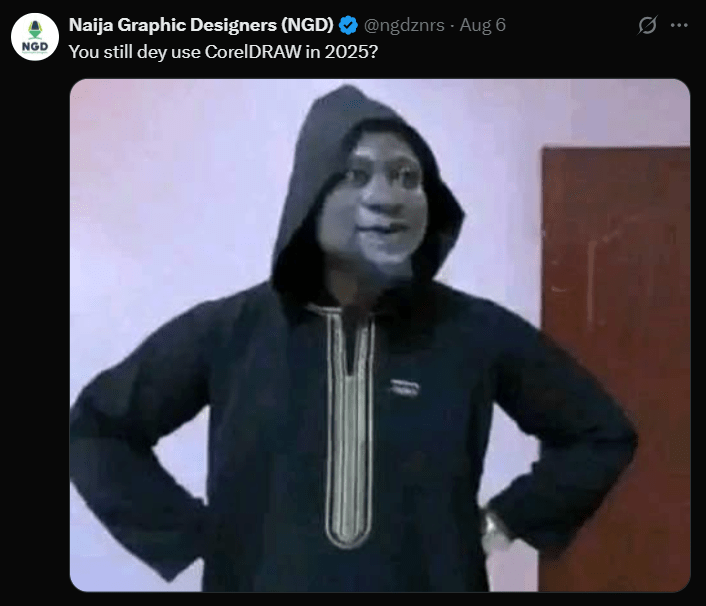You’ve just done a peng flier design. The client loves it, you love it, and with design pride, you hit send to dear printer.
There’s a notification minutes after sending on your top panel, which reads a complaint thousands face: “ Oga, It’s not in CorelDRAW.”
Dumbfounded, you scratch your head, wondering why Nigerian printers are relatively obsessed with CorelDRAW.
If anything, you even sent the PSD file. Yet he’s adamant, even saying, “You don’t know your job,” and reporting you to the client.
If this is you, then you’ve just come face-to-face with the printing preference for CorelDRAW.
This preference sparks the endless debate: Between Photoshop, the darling of many designers, and CorelDRAW; many see Photoshop is the new, shiny option, and CorelDRAW is a choice by printers due to tradition and stubbornness.
But could there be something more to it?
We Asked a Printer
To put the debate to rest, we caught up with a Nigerian printer to get his perspective on the Photoshop vs CorelDRAW conversation.
Our goal was simple: find out whether this preference is rooted in professional reasons or just habit.
The results are so illuminating that we think it finally puts an end to the debate between Photoshop vs CorelDRAW
Find out why your darling printer chose CorelDRAW over Photoshop.
Questions with a Nigerian printer
1. Can we meet you?
“My name is Matthew, and I’ve been in printing for 16 years. It started from a passion for printing. I noticed a gap in accessing publishing firms for small print jobs. So I got into the business to make it easier for people to access decent print firms for publishing their work.
I’ve handled the printing of materials like books without demanding the large minimum quantities that publishing firms often require.”
2. Why is CorelDRAW a preference for Nigerian printers?
“Photoshop’s features are tailored for photo editing, while CorelDRAW is built with print in mind, that’s the fact most people overlook.
With CorelDRAW, you can edit a flyer even after it has been sent, adjust curves, change fonts, tweak resolution without starting from scratch. Photoshop files don’t offer that level of flexibility. It’s not a weakness, just a difference in purpose.”
3. Any advantages of Photoshop then?
“It’s all about the use case. Photoshop is excellent for photo manipulation and editing that’s where it shines. But when it comes to print, the large file sizes it generates can be a challenge.”
4. Any Tips for sending files to a printer
“When a file is in CorelDRAW, printers rarely have issues. Printers work with CMYK colors, and CorelDRAW can handle CMYK color separations directly, sending all plates to the RIP software or printer at once.
Photoshop, on the other hand, requires a bit more preparation. The key is to work with the end goal in mind, especially when collaborating with a printer.”
Choosing the Right Tool
There you have it The end goal and project e.g photoediting or print determines the best type softare for graphic design .
Here’s a recap of what you’ve learned:
- For logos, illustrations, and scalable designs, CorelDRAW is generally preferred for its vector capabilities.
- For photo editing, retouching, and complex raster-based designs, Photoshop is the better choice for raster files.
- For print design: Both can be used effectively, but CorelDRAW’s CMYK separation features are a big plus, while Photoshop’s image editing tools are unbeatable for certain tasks.
Hopefully, this settles the debate or at least makes your choice easier.

Join the Twitter banter and share your own experiences.
But Don’t Stop Here
We’ve answered the Photoshop vs CorelDRAW question, but in doing so, we’ve touched on terms like CMYK, RGB, and color separation.
If those sound unfamiliar, we have a full resource library to get you up to speed.
Check out our guide on RGB, CMYK, and Color Separation and take your design game to the next level.